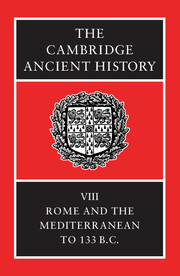Book contents
- Frontmatter
- Contents
- List of maps
- List of text-figures
- Preface
- 1 Sources
- 2 The Carthaginians in Spain
- 3 The Second Punic War
- 4 Rome and Greece to 205 B.C.
- 5 Roman expansion in the west
- 6 Roman government and politics, 200-134 B.C.
- 7 Rome and Italy in the second century B.C.
- 8 Rome against Philip and Antiochus
- 9 Rome, the fall of Macedon and the sack of Corinth
- 10 The Seleucids and their rivals
- 11 The Greeks of Bactria and India
- 12 Roman tradition and the Greek world
- 13 The transformation of Italy, 300 – 133 B.C. The evidence of archaeology
- Three Hellenistic Dynasties
- Genealogical Tables
- Chronological Table
- BIBLIOGRAPHY
- Index
- Map 11: Greece and Asia Minor
- Map 13: Asia Minor and Syria
Preface
Published online by Cambridge University Press: 28 March 2008
- Frontmatter
- Contents
- List of maps
- List of text-figures
- Preface
- 1 Sources
- 2 The Carthaginians in Spain
- 3 The Second Punic War
- 4 Rome and Greece to 205 B.C.
- 5 Roman expansion in the west
- 6 Roman government and politics, 200-134 B.C.
- 7 Rome and Italy in the second century B.C.
- 8 Rome against Philip and Antiochus
- 9 Rome, the fall of Macedon and the sack of Corinth
- 10 The Seleucids and their rivals
- 11 The Greeks of Bactria and India
- 12 Roman tradition and the Greek world
- 13 The transformation of Italy, 300 – 133 B.C. The evidence of archaeology
- Three Hellenistic Dynasties
- Genealogical Tables
- Chronological Table
- BIBLIOGRAPHY
- Index
- Map 11: Greece and Asia Minor
- Map 13: Asia Minor and Syria
Summary
The span of time embraced by this volume is short. Some who could recall personal memories of its beginnings - perhaps the news of Hannibal's crossing of the Alps, or of the disaster at Cannae - witnessed events not far from its close; such people witnessed also an astonishingly rapid and dramatic sequence of developments which gave Rome the visible and effective political mastery of the Mediterranean lands. The beginnings of this change lie far back in the history of the Romans and of other peoples, in events and institutions which are examined in other volumes in this series (especially in Volume vn.2); but the critical period of transition, profoundly affecting vast territories and numerous peoples, lasted little more than half a century. In one sense a single episode, it nonetheless comprised a multiplicity of episodes which varied greatly in scale and character and in the diversity of those who, whether by conflict, by alliance, or by the passive acceptance of new circumstances, passed under Roman domination. Furthermore, the Romans themselves experienced change, and not merely in the degree of power and surpemacy which they enjoyed. That power, along with the material fruits and practical demands of empire, brought consequences of great moment to their own internal political affairs, to relationships within their society and between them and their Italian neighbours, to their cultural life and to the physical expressions of that life.
- Type
- Chapter
- Information
- The Cambridge Ancient History , pp. xi - xivPublisher: Cambridge University PressPrint publication year: 1989

